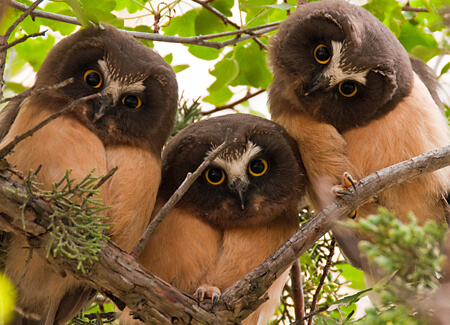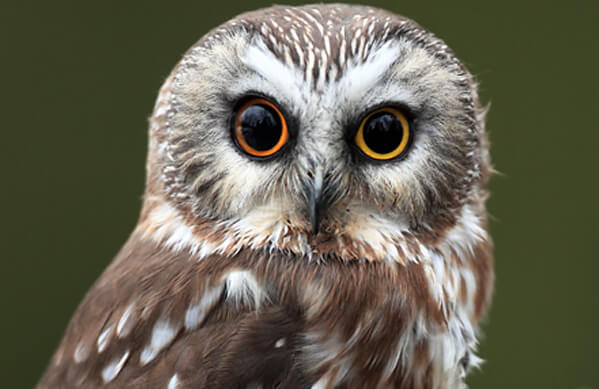 The tiny Northern Saw-whet Owl is almost as diminutive as the Elf Owl and Peru's Long-whiskered Owlet. Named for its repeated tooting whistle, some say the bird sounds like a saw being sharpened on a whetstone. It has bright yellow eyes and a large, rounded head without ear tufts.
The tiny Northern Saw-whet Owl is almost as diminutive as the Elf Owl and Peru's Long-whiskered Owlet. Named for its repeated tooting whistle, some say the bird sounds like a saw being sharpened on a whetstone. It has bright yellow eyes and a large, rounded head without ear tufts.
Saw-whet Owls sometimes fall victim to collisions, and the mature forest habitat they favor is increasingly lost. In addition, habitat shifts caused by climate change may affect the southern range limit of this species in the future.
Sign up for ABC's eNews to learn how you can help protect birds
Saw-whet Owls may be preyed upon by larger species of owls and hawks. Starlings and squirrels compete with them for nesting cavities and also plunder nests and kill owlets.
A True Night Owl
Northern Saw-whet Owls are almost entirely nocturnal and are far more often heard than seen. They spend the daylight hours roosting quietly in thick cover, where their presence is sometimes betrayed by the scolding of a mob of smaller birds.
Although they vocalize year-round, Northern Saw-whets can be heard more often during their breeding season (April through June), when they are looking for mates. They nest in tree cavities, where the female does all of the incubation and brooding while the male hunts.
When prey is plentiful, they will kill more than they can eat at once, caching the excess in a safe place.

Juvenile Saw-whet Owls by Kathy+Sam
Learning More About Saw-whets
Most saw-whets nest in coniferous forests of the north and migrate south to winter in mixed or deciduous woods. Saw-whet migration had been poorly understood because of their nocturnal, reclusive behavior, but Project Owlnet, begun in the 1990s, has been gathering information on their movements via a network of over 100 owl migration banding sites.
Landowners can help this owl by allowing dead trees to remain standing to provide nest cavities. Saw-whets take readily to nest boxes, which can also be used to mitigate the loss of natural sites.
Donate to support ABC's conservation mission!



















































